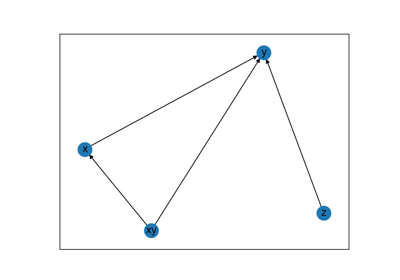causal_networkx.discovery.PC#
- class causal_networkx.discovery.PC(ci_estimator, alpha=0.05, init_graph=None, fixed_edges=None, min_cond_set_size=None, max_cond_set_size=None, max_iter=1000, max_combinations=None, apply_orientations=True, **ci_estimator_kwargs)[source]#
Methods
convert_skeleton_graph(graph)Convert skeleton graph as undirected networkx Graph to CPDAG.
fit(X)Fit constraint-based discovery algorithm on dataset 'X'.
learn_skeleton(X[, graph, sep_set, fixed_edges])Learns the skeleton of a causal DAG using pairwise independence testing.
orient_edges(skel_graph, sep_set)Orient edges in a skeleton graph to estimate the causal DAG, or CPDAG.
test_edge(data, X, Y[, Z])Test any specific edge for X || Y | Z.
- convert_skeleton_graph(graph)[source]#
Convert skeleton graph as undirected networkx Graph to CPDAG.
- fit(X)#
Fit constraint-based discovery algorithm on dataset ‘X’.
- Parameters:
X :
Union[pd.DataFrame,Dict[Set,pd.DataFrame]]Either a pandas dataframe constituting the endogenous (observed) variables as columns and samples as rows, or a dictionary of different sampled distributions with keys as the distribution names and values as the dataset as a pandas dataframe.
- Raises:
-
If ‘X’ is a dictionary, then all datasets should have the same set of column names (nodes).
Notes
Control over the constraints imposed by the algorithm can be passed into the class constructor.
- Return type:
- learn_skeleton(X, graph=None, sep_set=None, fixed_edges=None)#
Learns the skeleton of a causal DAG using pairwise independence testing.
Encodes the skeleton via an undirected graph,
networkx.Graph. Only tests with adjacent nodes in the conditioning set.- Parameters:
X :
pd.DataFrameThe data with columns as variables and samples as rows.
graph :
nx.GraphThe undirected graph containing initialized skeleton of the causal relationships.
sep_set :
setThe separating set.
fixed_edges :
set, optionalThe set of fixed edges. By default, is the empty set.
return_deps : bool
Whether to return the two mappings for the dictionary of test statistic and pvalues.
- Returns:
skel_graph :
nx.GraphThe undirected graph of the causal graph’s skeleton.
The separating set per pairs of variables.
- Raises:
-
If the nodes in the initialization graph do not match the variable names in passed in data,
X.If the nodes in the fixed-edge graph do not match the variable names in passed in data,
X.
Notes
Learning the skeleton of a causal DAG uses (conditional) independence testing to determine which variables are (in)dependent. This specific algorithm compares exhaustively pairs of adjacent variables.
- orient_edges(skel_graph, sep_set)[source]#
Orient edges in a skeleton graph to estimate the causal DAG, or CPDAG.
Uses the separation sets to orient edges via conditional independence testing. These are known as the Meek rules [1].
- Parameters:
skel_graph :
causal_networkx.CPDAGA skeleton graph. If
None, then will initialize PC using a complete graph. By default None.sep_set :
Dict[Dict[Set]]The separating set between any two nodes.
- :rtype:py:class:
CPDAG
- :rtype:py:class:
- test_edge(data, X, Y, Z=None)#
Test any specific edge for X || Y | Z.
